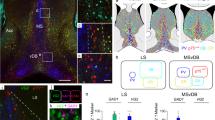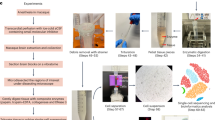Abstract
The activity of the basal forebrain cholinergic neurons (BFCNs) that innervate the cerebral cortex and hippocampus is essential for normal learning and memory. Here, we present a method to isolate and culture BFCNs from the embryonic murine septum that takes advantage of their restricted expression of the nerve growth factor receptor (p75) in conjunction with fluorescence-activated cell sorting. The septal region dissection, cell dissociation and staining process, and cell sorting parameters are described in detail. Sufficient cell yield and optimized cell culture conditions make this protocol suitable for multiple assays including immunocytochemistry, reverse transcriptase PCR, microarray profiling, acetylcholine measurements and electrophysiological assessment. The study of these neurons as a purified population will greatly advance our understanding of factors that influence their development and maintenance.
This is a preview of subscription content, access via your institution
Access options
Subscribe to this journal
Receive 12 print issues and online access
$259.00 per year
only $21.58 per issue
Buy this article
- Purchase on Springer Link
- Instant access to full article PDF
Prices may be subject to local taxes which are calculated during checkout





Similar content being viewed by others
References
Dutar, P., Bassant, M.H., Senut, M.C. & Lamour, Y. The septohippocampal pathway: structure and function of a central cholinergic system. Physiol. Rev. 75, 393–427 (1995).
Fibiger, H.C. The organization and some projections of cholinergic neurons of the mammalian forebrain. Brain Res. 257, 327–388 (1982).
Mesulam, M.M., Mufson, E.J., Levey, A.I. & Wainer, B.H. Cholinergic innervation of cortex by the basal forebrain: cytochemistry and cortical connections of the septal area, diagonal band nuclei, nucleus basalis (substantia innominata), and hypothalamus in the rhesus monkey. J. Comp. Neurol. 214, 170–197 (1983).
Lopez-Coviella, I., Berse, B., Krauss, R., Thies, R.S. & Blusztajn, J.K. Induction and maintenance of the neuronal cholinergic phenotype in the central nervous system by BMP-9. Science 289, 313–316 (2000).
Greferath, U., Bennie, A., Kourakis, A. & Barrett, G.L. Impaired spatial learning in aged rats is associated with loss of p75-positive neurons in the basal forebrain. Neuroscience 100, 363–373 (2000).
Sweeney, J.E., Hohmann, C.F., Oster-Granite, M.L. & Coyle, J.T. Neurogenesis of the basal forebrain in euploid and trisomy 16 mice: an animal model for developmental disorders in Down syndrome. Neuroscience 31, 413–425 (1989).
Dawbarn, D., Allen, S.J. & Semenenko, F.M. Coexistence of choline acetyltransferase and nerve growth factor receptors in the rat basal forebrain. Neurosci. Lett. 94, 138–144 (1988).
Woolf, N.J., Gould, E. & Butcher, L.L. Nerve growth factor receptor is associated with cholinergic neurons of the basal forebrain but not the pontomesencephalon. Neuroscience 30, 143–152 (1989).
Batchelor, P.E., Armstrong, D.M., Blaker, S.N. & Gage, F.H. Nerve growth factor receptor and choline acetyltransferase colocalization in neurons within the rat forebrain: response to fimbria–fornix transection. J. Comp. Neurol. 284, 187–204 (1989).
Koh, S. & Loy, R. Localization and development of nerve growth factor-sensitive rat basal forebrain neurons and their afferent projections to hippocampus and neocortex. J. Neurosci. 9, 2999–0318 (1989).
Sergent-Tanguy, S., Chagneau, C., Neveu, I. & Naveilhan, P. Fluorescent activated cell sorting (FACS): a rapid and reliable method to estimate the number of neurons in a mixed population. J. Neurosci. Methods 129, 73–79 (2003).
Ozdinler, P.H. & Macklis, J.D. IGF-I specifically enhances axon outgrowth of corticospinal motor neurons. Nat. Neurosci. 9, 1371–1381 (2006).
Lopez-Coviella, I. et al. Bone morphogenetic protein 9 induces the transcriptome of basal forebrain cholinergic neurons. Proc. Natl. Acad. Sci. USA 102, 6984–6989 (2005).
Allen, T.G., Abogadie, F.C. & Brown, D.A. Simultaneous release of glutamate and acetylcholine from single magnocellular 'cholinergic' basal forebrain neurons. J. Neurosci. 26, 1588–1595 (2006).
Hefti, F., Hartikka, J. & Sanchez-Ramos, J. Dissociated cholinergic neurons of the basal forebrain in culture. in A Dissection and Tissue Culture Manual of the Nervous System, 172–182 (eds: Shahar, A., de Vellis, J., Vernadakis, A. & Haken, B. Wiley-Liss Inc., New York, 1989).
Naumann, T. et al. Complete deletion of the neurotrophin receptor p75NTR leads to long-lasting increases in the number of basal forebrain cholinergic neurons. J. Neurosci. 22, 2409–2418 (2002).
Tallini, Y.N. et al. BAC transgenic mice express enhanced green fluorescent protein in central and peripheral cholinergic neurons. Physiol. Genomics 27, 391–397 (2006).
Acknowledgements
We thank Yanhui Deng and Stephen Kwok of the Boston University Medical Center Flow Cytometry Core Facility and the Tufts University Flow Cytometry Core in Pathology, respectively, for their expertise in FACS. p75 knockout Po mice were kindly provided by Dr Susan Birren. We thank Dr Michael Kotlikoff for providing ChAT-eGFP founder males for colony establishment. This work was supported by NIA grant AG 009525.
Author information
Authors and Affiliations
Corresponding author
Supplementary information
Supplementary Fig. 1
Specificity of the ATS anti-p75 antibody (PDF 133 kb)
Supplementary Video
Dissection of embryonic forebrain septa (MOV 25823 kb)
Rights and permissions
About this article
Cite this article
Schnitzler, A., Lopez-Coviella, I. & Blusztajn, J. Purification and culture of nerve growth factor receptor (p75)-expressing basal forebrain cholinergic neurons. Nat Protoc 3, 34–40 (2008). https://doi.org/10.1038/nprot.2007.477
Published:
Issue Date:
DOI: https://doi.org/10.1038/nprot.2007.477
This article is cited by
-
Central Cholinergic Synapse Formation in Optimized Primary Septal-Hippocampal Co-cultures
Cellular and Molecular Neurobiology (2021)
-
Upregulation of RIN3 induces endosomal dysfunction in Alzheimer’s disease
Translational Neurodegeneration (2020)
-
BDNF-, IGF-1- and GDNF-Secreting Human Neural Progenitor Cells Rescue Amyloid β-Induced Toxicity in Cultured Rat Septal Neurons
Neurochemical Research (2012)
-
p75NTR-dependent, myelin-mediated axonal degeneration regulates neural connectivity in the adult brain
Nature Neuroscience (2010)
-
Isolation and enrichment of embryonic mouse motoneurons from the lumbar spinal cord of individual mouse embryos
Nature Protocols (2010)
Comments
By submitting a comment you agree to abide by our Terms and Community Guidelines. If you find something abusive or that does not comply with our terms or guidelines please flag it as inappropriate.



